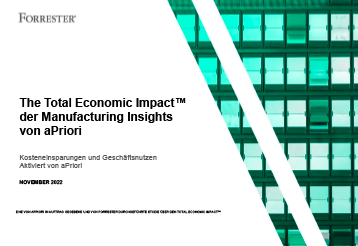Key Takeaways:
- TE Connectivity uses aPriori’s data-driven cost analysis to establish accurate “should costs” amid inflation and other market pressures
The Full Article:
Collaboration throughout the manufacturing supply chain is crucial to addressing inflationary pressures and economic uncertainty. Manufacturers can improve enterprise-wide productivity, reduce product costs, and drive sustainable innovations by harnessing actionable data.
Learn how TE Connectivity, a global innovator of sensors and connectivity solutions, uses sourcing and procurement data to reduce the cost of products, mitigate inflationary effects, and drive innovation through supplier process improvements.
TE Connectivity’s Center of Excellence for Cost of Goods Sold (COGS)
Sixteen-billion-dollar global design and manufacturing company TE Connectivity produces more than 236 billion products annually. Its diverse product portfolio serves communications, industrial, and transportation sectors through its product brands, such as AMP, Buchanan, and DEUTSCH.
The company provides connectivity and reliability that ensures the flow of critical data and power across products and technologies all around us – from life-saving medical devices to advanced energy utilities serving millions of consumers. To meet demand across consumer, industrial, and defense industries, TE Connectivity combines its 106 manufacturing sites worldwide with a robust network of suppliers.
A key to the company’s success is attributed to its Centers of Excellence (COE) model, which focuses on applying specialized expertise to address core business issues. Sylwia Lambert leads the COE of Procurement Cost Analytics (PCA) and describes it as a group of cost engineers dedicated to two main initiatives. During aPriori’s Manufacturing Insights Conference, she presented how TE Connectivity uses aPriori to achieve its goals, “The first one is cost modeling, which aPriori helps us with. The second is process improvement and leveraging our internal manufacturing teams to bring solutions to our supply base where they might be lacking,” said Lambert.
Due to ongoing market volatility, the PCA COE team faces challenges in assessing and mitigating critical product costs.
Three Examples of Analyzing Product Costs
Like other manufacturers, TE Connectivity’s PCA COE team is dealing with increased supplier costs due to economic and geopolitical pressures. The procurement team requires supplier transparency to understand how an increased quote aligns with overall inflationary costs caused by fixed and variable costs, including manufacturing overhead, direct labor, and direct materials.
To address such issues, Lambert shared three examples in her presentation of the expenditures that the PCA COE tackles by leveraging aPriori’s automation-driven should cost solution:
1. Do Rising Energy Costs Justify a 14% Supplier Increase?
The Cost Situation: A supplier has recently increased its energy costs by more than 300% and requested a 9-10% price increase to manufacture a specific product for TE Connectivity.To determine whether the requested 9% increase is reasonable, the PCA COE team needs to investigate the supplier’s new energy expenses.
The aPriori Impact: The team used the aPriori platform to analyze the percentage of energy contributing to factory overhead and the total product cost. “We compared the machine overhead rate, which contributes the most energy out of a product cost when looking at it from the bottom up,” said Lambert. “We then adjusted the energy from the original to the new inflated cost, increasing the machine rate by 14%. So, 14%, but how much of that machine rate impacts the product? And after doing this analysis, we realized it was 4%.”
With aPriori’s precise estimates, the PCA COE team can initiate fact-based negotiations with the supplier regarding the overall piece price of 4%. Moreover, aPriori can compare existing and new cost models by considering regional energy expenses. The team can leverage scenario comparisons in aPriori to gain a data-backed understanding of how these costs truly impact the unit cost of a particular product or finished good (component).
2. Does a Complex Manufacturing Process Warrant a 30% Increase?
The Cost Situation: A TE Connectivity supplier has raised its production costs by a considerable 30% during the past three years. The supplier claims this increase is due to the high costs associated with its complex manufacturing processes.
Market Analysis Reveals Copper Cost Reduction: The PCA COE team analyzed their overall product costs and discovered that nearly 65% comes from raw materials, specifically copper. Additionally, their research showed that copper prices have decreased by 15% in the current market. This allowed the team to negotiate with the supplier and level out the 15% it received from the raw materials.
The aPriori Impact: To further optimize cost control with greater precision, TE Connectivity can use aPriori to compare the real-time cost implications of alternative designs and production. aPriori estimates are highly precise and based on real-world variables such as direct labor, manufacturing overhead costs, raw materials, and more.
Discover how aPriori can replicate real-world factories to improve product cost decision-making.
3. Why are Labor and Manufacturing Quotes 2X the Regional Average?
The Cost Situation: TE Connectivity was evaluating potential suppliers and requested full disclosures of costs in this process. During the assessment, a supplier based in Mexico provided a quote for labor and machine hourly rates for its 110-ton machine.
The aPriori Impact: The PCA COE leveraged aPriori’s digital factories to run various country-specific cost assessments and scenarios by making use of Regional Data Libraries (RDLs). They found that the supplier’s quoted direct labor cost was around double the country’s average. Moreover, the supplier’s quoted machine hourly rate greatly surpassed aPriori’s estimated rate in Mexico and the U.S.
With this background, TE Connectivity gains a stronger position to negotiate with the supplier. From Lambert’s presentation, “You have very clear talking points with your supplier to say, ‘Okay, you’re clearly two times higher than the U.S. rate in this case. What numbers are you using in your calculation?’”
Watch how TE Connectivity uses aPriori data-driven cost analysis to combat inflation.
Innovating for a Sustainable Competitive Advantage With aPriori
TE Connectivity is committed to sustainable innovation, striving to maintain consistent environmental, social, and governance (ESG) performance. Its science-based targets initiative focuses on reducing Scope 1, 2, and 3 emissions and minimizing its carbon impact on products, people, and the planet.
To achieve this goal, the organization employs aPriori’s robust solution to optimize product designs for cost while also gaining real-time insights into sustainability. With aPriori, the manufacturer can reduce cradle-to-gate greenhouse gas (GHG) emissions in the supply chain (Scope 3). This is achieved by monitoring the direct impact of process optimization on sustainability metrics like carbon dioxide equivalent (CO2e) emissions.
One example of aPriori’s impact on TE Connectivity’s sustainability goals is through the resin stream mapping production process. This process initially included scrap parts, production issues, and other factors that contributed to total waste. However, aPriori helped the team identify the waste and material reduction impact that regrind activities achieve as part of the overall resin stream mapping process.
In an ideal situation, the amount of resin in kilograms (kgs) used in production aligns with the material kgs in each product. The team uses aPriori to evaluate material requirements for each product, with a focus on reducing Scope 3 emissions. Ultimately, the aim is to minimize overall material usage, reduce waste, and support sustainable procurement practices.
Strengthening Relationships With Suppliers to Achieve Manufacturing Success
TE Connectivity effectively manages the impact of inflationary pressures and supply chain disruptions on product costs with aPriori’s data-driven insights. Through proactive assessment and negotiation of raw materials and other product costs, the manufacturer continues to fortify its market position while strengthening supplier relationships.
Get a 600% ROI With aPriori
Read Forrester's study to learn how aPriori can cut costs and drive growth.






